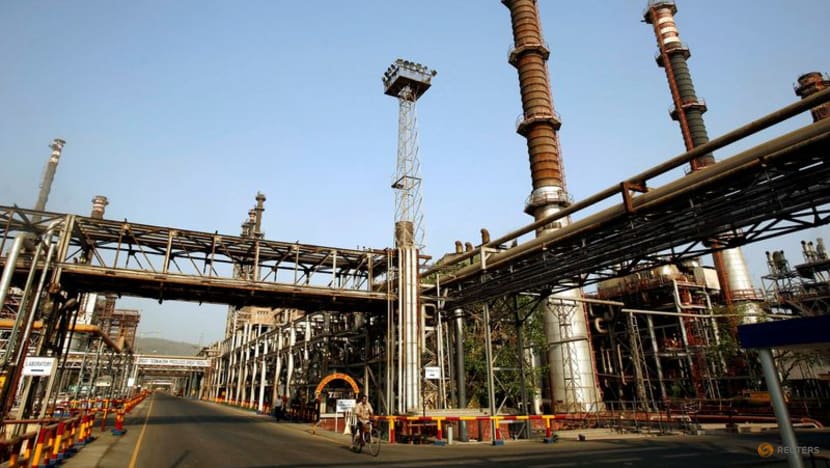CNA Explains: Why India buys Russian oil and will it yield to Trump's tariff pressure?
How will Trump's higher tariffs of 50 per cent affect India? Can it find alternative sources of crude? And why has India been singled out even though China buys more Russian oil?

A worker rides a bicycle at the Bharat Petroleum Corporation Ltd refinery in Mumbai on April 24, 2008. (File photo: Reuters/Punit Paranjpe)
SINGAPORE: US President Donald Trump on Wednesday (Aug 6) announced an additional 25 per cent tariff on India over its purchase of Russian oil, bringing the combined levy to 50 per cent.
This brought ties between India and the US to a new low.
CNA looks at how India's Russian oil imports have grown in recent years, why this is an issue for Trump and the potential impact of the higher tariffs.
Why does India import oil from Russia?
As one of the world’s largest oil consumers, India relies on foreign suppliers for more than 85 per cent of its oil needs.
The country traditionally relied on the Middle East for its oil supply. However, the outbreak of the Ukraine war in 2022 and Western sanctions on Russia presented an opportunity for New Delhi to obtain discounted crude from Moscow.
The cheaper oil has reduced costs for Indian refiners.
In 2024, Russia accounted for nearly 36 per cent of India's total crude oil imports, up from roughly 2 per cent before the war, according to data released by the country's commerce ministry.
The price advantage of Russian oil has narrowed over the years, dropping from around 14 per cent in the 2023 to 2024 financial year to about 7 per cent in 2024 to 2025.
But it remains economically attractive for India.
Why is the US concerned?
The US has said that India’s purchase of Russian crude is fuelling Moscow’s war effort in Ukraine.
Although Ukraine's Western allies have repeatedly sought to hobble Russia's export earnings, Moscow has been able to redirect energy sales from Europe to other countries, including India and China.
Apart from geopolitical reasons, there are economic considerations.
Trump’s trade advisor Peter Navarro told reporters on Wednesday that India was the “maharaja of tariffs”.
New Delhi’s high tariffs and non-tariff barriers meant the US sends “a lot of dollars overseas to India to buy their products in an unfair trade environment”, he said.
“India then uses American dollars to buy Russian oil.”
How will Trump’s latest tariffs affect India?
Indian exporters warned that additional US tariffs risked making businesses "not viable", especially for small- to medium-sized enterprises where profit margins are already thin.
"The 50 per cent reciprocal tariff effectively imposes a cost burden, placing our exporters at a 30 to 35 per cent competitive disadvantage compared to peers from countries with (a) lesser reciprocal tariff," said S C Ralhan, president of the Federation of Indian Export Organisations.
He added that the tariffs were “a severe setback” for India's exports.
Manoranjan Sharma, the chief economist at Indian credit rating agency Infomerics Ratings, told Reuters that the tariffs would hit India’s gross domestic product and affect employment to a certain extent.
But while the tariffs were concerning, he said there was no reason for alarm as India is “a largely domestically driven economy”, with exports accounting for about 18 per cent of India's GDP.
Sharing that view, Ranjeet Mehta, secretary-general of India's PHD Chamber of Commerce and Industry, said that the Indian economy is “very resilient and very robust”.
“This is an opportunity to diversify to other markets of the world,” he told Reuters.
“I think that this is the time to really realign the supply chain and focus on economies other than the US for the time being. However, we request, we urge both the government of India and the government of the US to engage in a dialogue so that these disruptions can be sorted out."
Can India diversify its oil sources?
India's foreign ministry said on Monday that it began importing from Russia because traditional oil supplies were diverted to Europe after the outbreak of the Ukraine war.
India still sources crude oil from parts of the Middle East, such as Iraq, Saudi Arabia and the United Arab Emirates. The region accounted for 45 per cent of the country’s total imports in 2024.
According to Minister of Petroleum and Natural Gas Hardeep Singh Puri, India has diversified its sources of supply to about 40 countries. More supply is coming onto the market from Guyana, Brazil and Canada, he added.
So India could find other suppliers to meet its energy needs relatively easily. The question is cost - as none of India's other alternatives offer the same price advantage as Russia.
What next for India?
The Indian government on Wednesday called the additional tariffs “unfortunate”.
“We reiterate that these actions are unfair, unjustified and unreasonable,” foreign ministry spokesman Randhir Jaiswal said in a statement, adding that India would take all actions necessary to protect its interests.
Jaiswal said India has already made its stand clear that the country’s imports were based on market factors and were part of an overall objective of ensuring energy security for its 1.4 billion people.
One analyst said the new tariffs put Prime Minister Narendra Modi in a bind.
"India is now in a trap - because of Trump's pressure, Modi will reduce India's oil purchases from Russia, but he cannot publicly admit to doing so for fear of looking like he's surrendering to Trump's blackmail," said Ashley Tellis at Washington's Carnegie Endowment for International Peace.
Reuters previously reported that India’s state refiners had paused Russian oil purchases.
Can the US do the same to China?
China is the biggest importer of Russian crude ahead of India. Türkiye is also a major buyer, and Trump has warned that countries purchasing Russian exports could face sanctions if Moscow fails to reach a peace deal with Ukraine.
But Trump could find it difficult to impose such tariffs on Beijing, Dr Susan Stone told CNA.
Dr Stone, Credit Union SA Chair of Economics at the University of South Australia, noted that US trade with China was five times larger than its trade with India.
“China's been showing its willingness to retaliate, and of course, it has the economic heft behind it to make those retaliatory measures more painful, maybe than other countries to the US,” she said.
“So it'll be interesting to see if the US threatens China, and then if it does, how that plays out.”
As part of a negotiating period with Beijing, Trump has placed 30 per cent tariffs on goods from China, a rate that is lower than the combined import taxes that India faces.
Ajay Srivastava, a former Indian trade official, told AP that Trump's decision on India was “hypocritical” given that China buys more Russian oil.
“Washington avoids targeting Beijing because of China’s leverage over critical minerals, which are vital for US defence and technology,” he said.

















